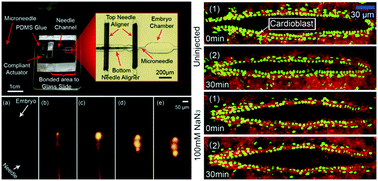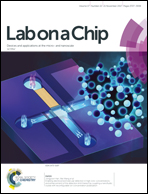A microfluidic microinjector for toxicological and developmental studies in Drosophila embryos†
Abstract
Microinjection is an established and reliable method to deliver biological reagents such as transgenic constructs and drugs, to specific locations inside organisms such as the Drosophila embryo and C. elegans worm. In this paper, a simple compliant mechanism based PDMS-microinjection system has been demonstrated. Unlike conventional microinjectors, this unique system could allow one to precisely insert a long taper microneedle laterally and at various positions inside the length of the Drosophila embryo (up to 250 μm) with the resolution of 5 μm. Volumes as low as 30 pL with accuracy of ±10 pL were delivered inside the embryo via pressure pulses. The device has been used to study the effect of toxins on cardiogenesis in Drosophila embryos. Using this device, we demonstrate that the cardioblast (CB) migration velocity is modified in a dose sensitive manner to varying doses of injected sodium azide (NaN3) and, for the first time, quantify the effect of the toxin on heart assembly. Injection with 40 pL of NaN3 was shown to decrease CB migration velocity and filopodia number at concentrations above 10 mM, while embryos injected with the tracer Rhodamine B (0 mM NaN3) displayed no significant difference when compared to uninjected embryos. This device can be potentially used for other embryonic assays, which require accurate delivery of the reagents to a specific location within the embryo.



 Please wait while we load your content...
Please wait while we load your content...